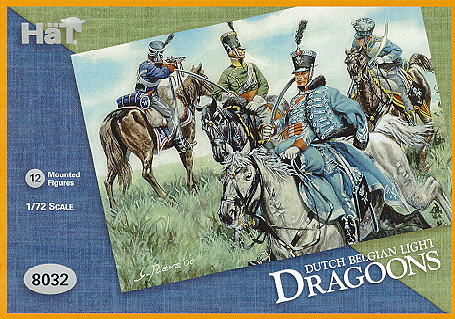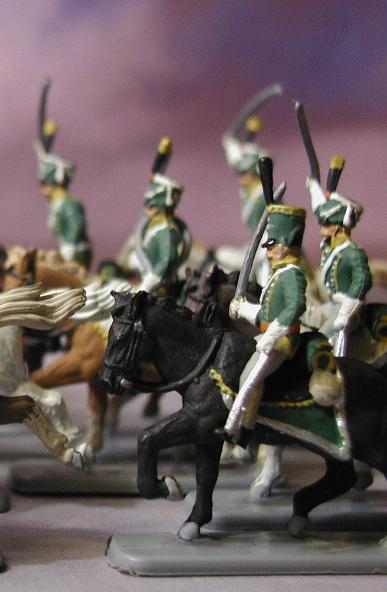
Dutch Belgian Light Dragoons Box



This set is composed of Dutch and Belgian Light Dragoons at Waterloo.
 Dutch-Belgian cavalry in 1815 consisted of 1 Heavy Brigade with the 1st (Dutch), 2nd (Belgian) and 3rd (Dutch) regiments of Carabiniers, and 2 Light Cavalry Brigades. The Light Cavalry Brigade of General de Ghigny was made up of the 4th Dragoons (Dutch) and 8th Hussars (Belgian), while the other Light Cavalry Brigade of General van Merlen consisted of the 5th Dragoons (Belgian) and 6th Hussars (Dutch). Altogether, the Dutch-Belgian Cavalry Division counted some 3400 men all ranks and formed 30% of Wellington's cavalry force. Most of the rank and file were young volunteers, but the subaltern and senior officers were mostly very experienced men who had seen their share of fighting during the Empire and would prove their worth in gold in the forthcoming campaign.
Dutch-Belgian cavalry in 1815 consisted of 1 Heavy Brigade with the 1st (Dutch), 2nd (Belgian) and 3rd (Dutch) regiments of Carabiniers, and 2 Light Cavalry Brigades. The Light Cavalry Brigade of General de Ghigny was made up of the 4th Dragoons (Dutch) and 8th Hussars (Belgian), while the other Light Cavalry Brigade of General van Merlen consisted of the 5th Dragoons (Belgian) and 6th Hussars (Dutch). Altogether, the Dutch-Belgian Cavalry Division counted some 3400 men all ranks and formed 30% of Wellington's cavalry force. Most of the rank and file were young volunteers, but the subaltern and senior officers were mostly very experienced men who had seen their share of fighting during the Empire and would prove their worth in gold in the forthcoming campaign.
On the 16th of June, Van Merlen's light cavalry brigade, after a forced march, arrived at Quatre-Bras in the nick of time to support the exhausted Dutch-Belgian defence of the crossroads. Although their charge met with little success, the 6th Hussars being completely routed and the 5th dragoons being fired upon by British infantry, the intervention by Van Merlen enabled Picton to deploy his infantry and stabilise the Allied line. Later in the day, Van Merlen's brigade countercharged against French cuirassiers who threatened to break through the allied position.
At Waterloo both Light Cavalry Brigades were hotly engaged all day. While Van Merlen's brigade remained in the center close to La Haye Sainte, Ghigny's brigade was sent from left to right several times in order to intervene wherever the situation called for it, at one time saving Vandeleur's dragoons from pursuit by French lancers. Both brigades suffered heavy casualties.
The set includes the 4th and 5th dragoons who were dressed with similar bell-topped shako's but had quite different uniforms. The 4th wore dark blue tunics faced red with white, hussar style frogging on the jacket while the 5th were dressed in plain green with yellow facings, similar to the French 6th Chasseurs ŕ Cheval. Armaments were of mixed French and British origin. An extra head is provided for an officer of the 4th dragoons, who wore French style cylindrical shako's. Extra accessories include a blanket roll which was worn across the shoulder as protection from sabrecuts.
André Dellevoet
The Netherlands.
Dutch Hussars, painted by Dr. Toni Lombarte of Catalonia, Spain.

Copyright 2000. All rights reserved. Any unauthorized use of content or images are violations of applicable laws and will be prosecuted to the fullest extent of the law.